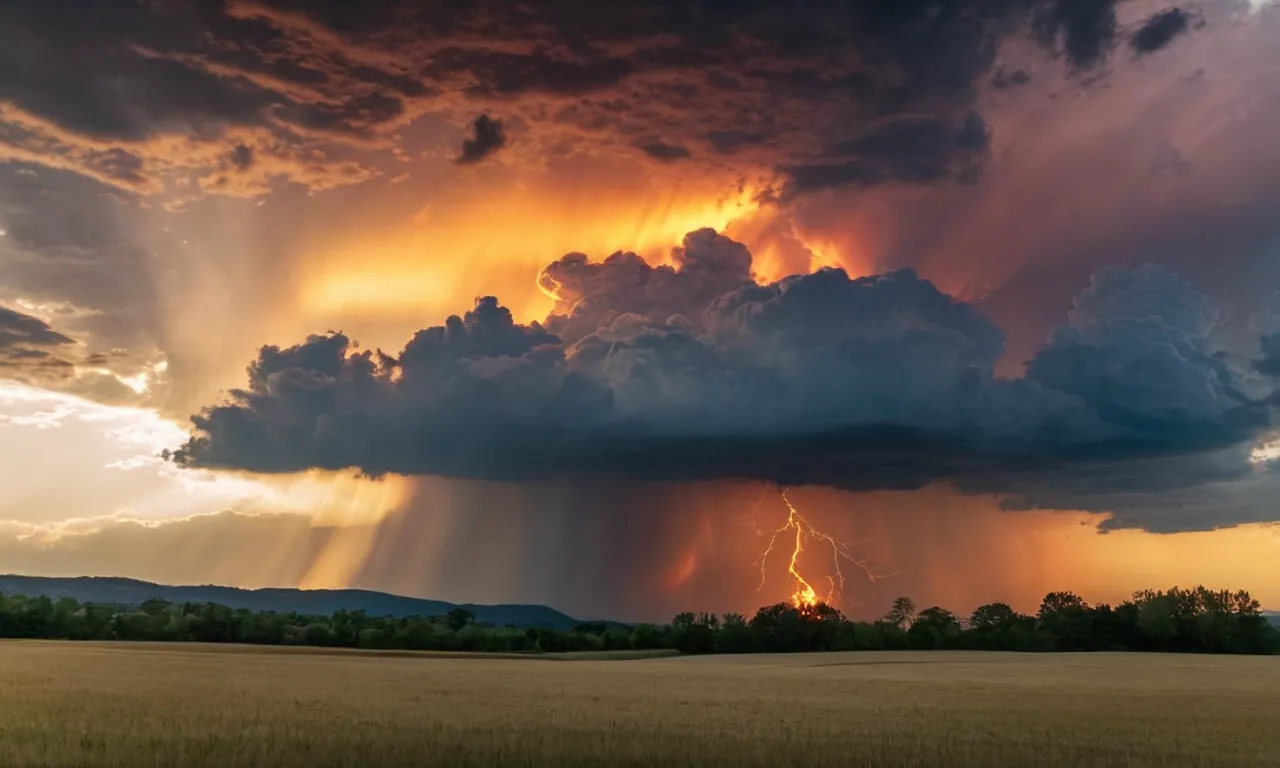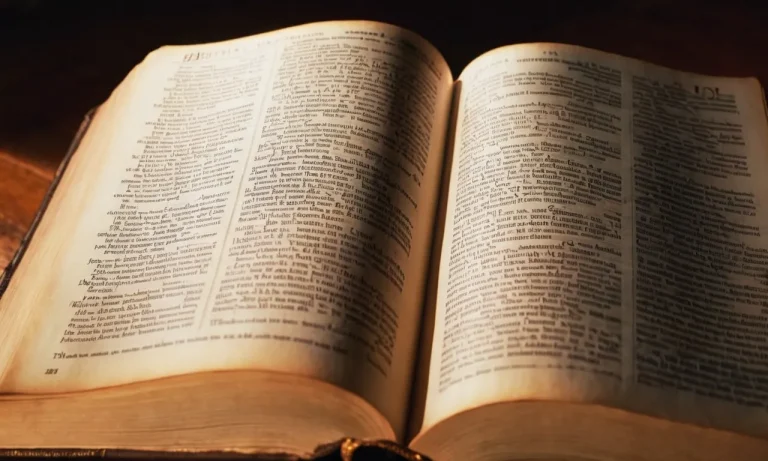Understanding The Wrath Of God In Revelation
The book of Revelation in the Bible is filled with vivid imagery of disasters, plagues, and destruction. These passages refer to the wrath of God being poured out on the earth and its wicked inhabitants. But what exactly does the wrath of God mean in Revelation?
If you’re short on time, here’s a quick answer to your question: The wrath of God in Revelation refers to God’s righteous anger and judgment against sin and evil. It is expressed through the seven seals, trumpets, and bowls depicting catastrophic end-times events before Jesus’ second coming.
In this comprehensive article, we will analyze the concept of God’s wrath in Revelation by looking at the key images depicting it, examining the purpose behind it, understanding it in relation to God’s justice and love, and reflecting on what it means for us today as we anticipate Christ’s return and the renewal of all things.
Understanding the Imagery and Language of God’s Wrath
The Seven Seals, Trumpets, and Bowls
In the book of Revelation, God’s wrath against sin and evil in the world is portrayed through a series of intense judgments depicted as seven seals, seven trumpets, and seven bowls being poured out on the earth.
These graphic images utilize numbers and objects familiar to people of John’s day to convey God’s seriousness about justice and judgement for unrepented sin.
The seven seals containing the scroll represent God enacting his plan to redeem creation and judge evil. As each seal is opened, judgment intensifies. The seven trumpets represent warning blasts and declarations of coming judgement.
The seven bowls filled with God’s wrath reflect the fullness and completeness of God’s righteous anger against stubborn, unrepentant sin.
While fantastical in imagery, these symbols powerfully communicate that God takes sin seriously and ultimately, perfect justice and judgement will prevail. Just as God liberated the Israelites from slavery in Egypt through plagues and miracles, God will liberate the world from the slavery of sin through definitive acts of judgement.
Symbolic Language Conveying a Serious Message
Revelation utilizes intense and even frightening symbolic language about judgement, plagues, and violence to underscore the seriousness of its message. However, interpreting these symbols literalistically can lead to distorted understandings of God’s character.
Rather than an angry tyrant, God is grieved by sin’s affliction in his beloved creation (Genesis 6:6). God’s wrath serves to make right what sin has made wrong. It isHis passion for perfect justice and restoration. God delays judgment so more may repent (2 Peter 3:7-10).
And when judgment comes, God still redeems those who turn to Him.
Additionally, the cosmic upheavals in Revelation point not just to God’s judgment of sin, but also to His final victory over evil and the coming of His eternal Kingdom. The layers of symbolism remind readers that God’s plans are infinitely bigger than one can imagine.
While God’s wrath is fearsome, true justice always carries hope. As in any good story, evil will not have the last word. God’s love and justice harmonizes all discord in a grand finale of redemption. The Gripping symbols of Revelation invite readers to align with God’s purposes through trust in Christ – purposes which lead to life rather than destruction.
The Purpose Behind God’s Wrath in Revelation
To Punish Evil and Bring Justice
The book of Revelation describes God pouring out His wrath on the wicked and unrepentant world in the end times (Revelation 16). This is to punish those who have rejected God’s ways and committed horrific evils, perverting justice and oppressing the vulnerable.
God cannot let injustice and evil go unanswered forever. As a righteous judge, there must be a reckoning for unrepented sins and crimes against humanity. Revelation shows that God will avenge “the blood of His servants” and bring justice to the oppressed through plagues, disasters, and destruction (Revelation 19:2).
This applies on an individual level but also to nations and empires built on violence, greed, immorality, and the backs of slaves. God’s judgment exposes the wickedness of economic exploitation, political corruption, religious hypocrisy, and moral decay in society.
To Call People to Repentance Before It’s Too Late
However, God’s wrath has a redemptive purpose – to warn people to turn from their sins before it’s too late. The plagues and judgments are meant to spur repentance through desperate crisis (Revelation 9:20-21).
God is reluctant to pour out His fury, preferring that all would heed Christ’s call to be reconciled with God (2 Peter 3:9). But He will not leave the unrepentant unjudged forever. The wrath depicted in Revelation is meant to wake people up through terrible calamity, that they might plead for mercy before the final judgment.
There have certainly been times in history where disaster, disease, famine, or war led societies to morally and spiritually self-reflect. The COVID-19 pandemic caused many to come face-to-face with their mortality and ultimate destiny.
The purpose of God’s wrath in Revelation seems aimed squarely at eliciting such a response before it’s eternally too late.
God’s Wrath in Relation to His Justice and Love
An Expression of God’s Holy and Righteous Character
God’s wrath is an expression of His intrinsically holy and righteous character towards sin. As the absolute standard of morality, God cannot simply turn a blind eye to evil, injustice, and wickedness. His wrath against sin arises from His pure nature (Habakkuk 1:13).
Yet God’s wrath is not an uncontrolled rage as some depict it. Rather, it is a measured and just response to humanity’s rebellion and guilt before their Creator.
Throughout Scripture, God’s judgment and wrath are repeatedly linked to His justice and righteousness (Psalm 7:11; Isaiah 5:16). He has established a moral order for creation and acts to uphold justice against those who violate His laws.
His wrath against sinners serves to rightfully restore the balance of justice that has been disrupted by rebellion against Him. It is thus an expression of His fair and impartial judgment as the Supreme Judge of the universe.
Some key biblical examples that demonstrate God’s wrath as an outworking of His justice include the flood in Noah’s day (Genesis 6:5-7) and the destruction of Sodom and Gomorrah (Genesis 18:20; 19:24).
In both accounts, these extreme measures of judgment served to punish the inhabitants’ wickedness and violence which had evidently reached unprecedented levels from God’s perspective. His wrath righteously upheld justice in the midst of rampant unrighteousness.
Motivated by Love to Protect His People and Renew Creation
While God’s wrath arises from His intrinsic holiness and righteousness, it is also significantly motivated by His great love. Scripture presents His judgments not as the actions of a vicious tyrant, but rather of a loving Father who disciplines (Hebrews 12:7-11) and a faithful Shepherd who protects His flock from savage wolves (Jeremiah 23:1-4).
His wrath serves to guard those He loves and to purify creation for the establishment of new heavens and a new earth (2 Peter 3:7-13).
This loving motivation behind God’s wrath is perhaps most vividly illustrated through Christ’s death on the cross. On the cross, God’s righteous anger against sin was fully appeased through His willingness to endure the suffering Himself out of His incomprehensible love for humanity (Romans 3:25; 5:8-9; 1 John 2:2).
God’s love absorbed His own wrath. What greater demonstration of merciful and gracious love could there be?
As the Book of Revelation depicts, the future outpouring of God’s wrath through the judgments and plagues will bring terrible destruction (Revelation 6-16). Yet its ultimate purpose is to punish wickedness (2 Thessalonians 1:5-10), protect His people Israel (Revelation 12:13-17), defeat His enemies (Revelation 19:11-21), and renew the earth for the age to come (Revelation 21-22).
God’s motivation is loving salvation rather than vicious condemnation.
Reflecting on the Significance of God’s Wrath Today
A Call to Reverence, Repentance, and Readiness
God’s wrath in Revelation serves as a sobering reminder that our holy and just God takes sin seriously. Though His wrath may be difficult to comprehend in our human frame of reference, it stems from His perfect righteousness and justice (Psalm 97:2).
As people created in God’s image, we must approach Him and His Word with reverence, humility, and repentance. The depiction of God’s wrath reveals the urgency of turning from sin and clinging to Christ, who bore God’s wrath on our behalf (1 Thessalonians 1:10).
It calls us to readiness and faithfulness as we await Christ’s return.
Seeing the horror of God’s wrath should drive us to our knees, pleading for mercy and grace while renouncing all known sin. Though punishment is deserved, Godrichly provides redemption through Jesus (Romans 3:23-26).
As recipients of undeserved grace, we should respond in grateful worship, pursuing holiness and Christlike character. God’s future wrath also underscores the need to share the gospel far and wide, while passionately interceding for the lost.
Moreover, awareness of coming wrath should instill in believers an eager expectation for Jesus’ return, which will liberate all creation from sin’s grip (Romans 8:18-25). Until then, we live faithfully by God’s power, overcoming temptation and shining as lights in a dark world (Matthew 5:14-16).
We can take confidence that God’s wrath will someday deal decisively with all evil, injustice, suffering and depravity. What wondrous hope for those who trust in Him!
Looking Forward to Christ’s Return and the New Creation
When Christ returns, He will vanquish evil forever and usher in a perfect, eternal state where God dwells with His people (Revelation 21:1-4). For now, we live in a fallen world still plagued by sin, though its power is broken for believers.
While we may face hostility and persecution, our living hope is anchored in the assurance that Jesus is coming soon to make all things new (Titus 2:13; 2 Peter 3:13).
Until that magnificent day, we persevere in holiness, watchfulness and evangelism. We take heart that God’s plan is unfolding perfectly toward Christ’s return and the fullness of His everlasting kingdom.
Our present trials are producing eternal glory, and our momentary afflictions are not worth comparing to the joys to come (2 Corinthians 4:16-18; Romans 8:18).
No matter how chaotic and unsettling the world becomes, we can trust God’s sovereign oversight of history. His purposes will prevail, and goodness will reign. The depiction of God’s wrath in Revelation propels us forward in holy urgency, kindles hope amid darkness, and anchors our lives in eternal perspective.
Maranatha! Come, Lord Jesus!
Conclusion
The vivid prophetic language about the wrath of God poured out in Revelation can seem frightening or confusing. Yet when we analyze the purpose behind these texts, we see they originate from God’s holy and loving character as well as His desire to bring justice, protect His people, defeat evil, and renew creation.
As we reflect on the wrath of God in Revelation, may we be reminded of the seriousness of sin, moved to repentance, and filled with hopeful anticipation for Jesus’ return when He will make all things new.
Rather than reacting in fear, we can respond in reverence, repentance, and readiness for that great day.








